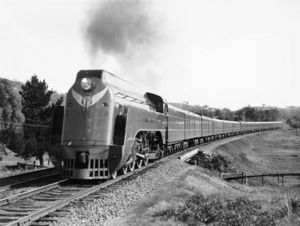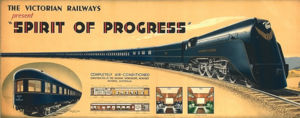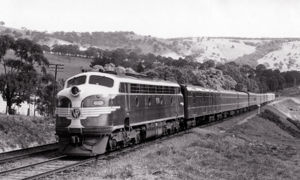Spirit of Progress
The Spirit of Progress was an Australian express train that ran on the Melbourne to Sydney mainline.
Contents
Route
From its introduction in 1937 until 1962 the train ran on 5 ft 3 in (1600 mm) broad gauge tracks out of Melbourne's Spencer Street Station and terminated at Albury, on the NSW/Victorian border, where passengers changed to a NSWGR train (the Melbourne Limited Express) running on 4 ft 8½ in (1435 mm) standard gauge track to complete their journey to Sydney. From the introduction of standard gauge from Melbourne to Sydney in 1962 until the demise of the Spirit of Progress in 1986, the train ran the complete distance between the two capital cities.
Broad Gauge service (1937-62)
The Spirit of Progress ushered in a standard of passenger train speed and comfort not previously seen in Australia. Its introduction in 1937 marked the culmination of many years of preparatory work by Victorian Railways, from the laying of heavier rail on the North Eastern line, introduction of Automatic Staff Exchange apparatus to allow continous high speed running between track sections, introduction of high-powered three cylinder Pacific locomotives, and the testing of air conditioning plant in passenger rolling stock. Such was the commitment of VR Chief Commissioner Harold W Clapp to introducing a world-class train service to Victorian Railways, virtually no detail was overlooked. Legend has it that VR engineers went as far as road testing the new dining car by placing a full bowl of soup on one of the tables and checking that none spilt as the train took curves along the route at 70 mph (112 km/h).[1]
Design & Innovation
When introduced, the train featured many innovations new to Australian railway practice, such as streamlining, full air-conditioning, and all-steel carriage construction. Its overall exterior and interior design reflected the latest Art Deco style, and interior fittings used materials such as stainless steel and native Australian blackwood veneers.[2] The luxurious new train also featured a dining car[3] with a modern galley kitchen modelled after the most up-to-date hospital kitchens of the period[2] and, at the rear, a round-ended parlour/observation car[4] offering panoramic views of the Victorian countryside as it disappeared into the distance.
Motive Power
VR's three cylinder S class 4-6-2 steam locomotives were assigned to haul the train, which could have a trailing load of up to 650 tons,[5] over the 1 in 50 gradients between Melbourne and Albury. Although these locomotives had been in service since 1928, their appearance was dramatically altered with the addition of streamlining and royal blue and gold livery designed to seamlessly match the train carriages.[6] The locomotives were also equipped with enormous tenders with enough water and coal capacity to enable the train to travel the entire 191 mile journey non-stop at an average speed of 52 mph,[7] which was the fastest (and longest non-stop) regularly scheduled train journey in Australia. Until the conversion of the S class locomotives to oil firing (which commenced from February 1951) the locomotive fireman was charged with the formidable task of shovelling six to seven tons of coal into the firebox during the course of each journey in order to generate enough power to maintain the schedule.
Launch
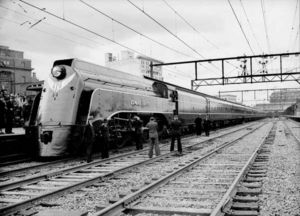
The Spirit of Progress was launched on November 17, 1937 in a blaze of publicity, which included dramatic footage being taken of the new train racing an Airco DH.4 aeroplane on its demonstration run to the Victorian city of Geelong.[8] During this run, the train set a new official Australian rail speed record of 79.5 mph (128 km/h). (NB: While not officially acknowledged, the Flaman speed recorder paper tape records - which were taken for every journey of the Spirit of Progress - reportedly show the train occasionally achieved speeds of up to 90 mph (145 km/h) while in regular service.)
Regular Service
After the successful launch of the service, the train settled into a routine that remained relatively unchanged for the next fifteen years. It departed Spencer Street Station at 6:30pm each evening, arriving at Albury shortly after 10pm. As well as cleaning of carriages and servicing of the locomotive, staff would also reverse the train back across the Murray River bridge to a turning triangle at Wodonga. This ensured that the locomotive and parlour car were facing their correct respective directions for the return trip to Melbourne, which departed at 7:55am the following morning.
Typical Consist of steam-hauled Spirit of Progress
When the Spirit of Progress began service in November 1937, it ran the following consist:
- S class 4-6-2 steam locomotive
- guard's van (later classed "CS")
- four second class cars (later classed "BS")
- dining car (later named "Murray")
- four first class cars (later classed "AS")
- parlour car (later named "Norman")
An additional first class car and a bulk mail van (later classed "DS") were built in April 1938. One second class car was removed from the standard consist to make way for the mail van. This left one spare sitting car of each class.
From 1941, the Spirit was occasionally hauled by VR's H class 4-8-4 in the event of one of the S class locomotives not being available.[9][10] Although the H class was limited to a maximum 60 mph (96km/h) top speed, its superior performance climbing steep gradients along the route reportedly compensated for its reduced top speed and allowed it to maintain the timetable.[11]
Conversion to diesel-electric power
From 1952, the S class steam locomotives were replaced by 1,500 hp B class (EMD ML2) diesel electric locomotives. Sadly, none of the iconic S class steam locomotives were saved for preservation. All were scrapped by September, 1954.
From 1956, open, 'saloon' style carriages began to replace the original compartment carriages of 1937.[12]
From 1957 onwards, the Spirit of Progress was also hauled by a new "S" class of 1,800 hp diesel electric locomotives (EMD A16C) that inherited the class designation and also carried over the names and numbers of the former S class steam locomotives.
Standard Gauge service (1962-86)
In 1962, the Spirit of Progress moved to the newly built Albury-Melbourne standard gauge line and began through running to Sydney.
The final run of the broad gauge Spirit of Progress and the inaugural run of the standard gauge service saw a brief return of steam power on the train. Veteran A2 class locomotives A2 995 and A2 996 hauled the final broad gauge Spirit from Seymour to Melbourne on 16th April 1962.[13] When the inaugural standard gauge Spirit of Progress from Melbourne reached Albury, the VR diesel locomotive was detached and NSWGR C38 class 4-6-2s 3813 and 3830 completed the journey from Albury to Sydney.
Secondary Role
From 1962, the Spirit's role as the premier train on the route was usurped by the new, stainless steel, all-sleeping car limited express, the Southern Aurora. The Spirit of Progress now stopped at intermediate stations not served by the Aurora, such as Goulburn, New South Wales.
The Spirit of Progress conveyed a through car between Melbourne and Canberra, three days per week in each direction from 1962 to 1974. The through car was detached at Goulburn and conveyed to Canberra attached to a mixed train.
The Spirit could no longer be considered a high-speed train service, with a timetabled 13 hour 45 minute journey from Sydney to Melbourne. It had also effectively ceased being a streamliner when hood unit X class diesel electrics began hauling it after 1966, and rolling stock such as sleeping cars and power vans from other trains with different liveries began to appear in consists.[14]
The sitting car accommodation offered by the Spirit of Progress, while exceptionally comfortable by 1937 standards for a 3¾ hour journey to Albury, was less than luxurious by 1962 standards for a 13¾ overnight journey to Sydney. Key features of the original Spirit of Progress consist, including the dining car and observation car, were not included in the new standard gauge service, further decreasing its amenity and prestige.
Typical Consist of 1970s Spirit of Progress
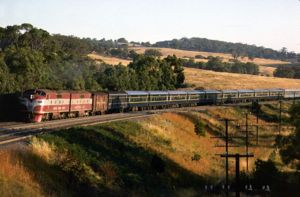
The following consist was recorded for a Spirit of Progress service that arrived in Melbourne on 30th April 1977:[15]
- X 50 (EMD G26C Co-Co diesel electric locomotive)
- VP 110 (VR freight louvre van)
- PHN 2361 (NSWGR power van)
- LAN 2344 (NSWGR sleeping car)
- NAM 2375 (NSWGR sleeping car)
- VBK 4 (VR first class saloon car)
- VFS 1, VFX 2 (VR second class compartment cars)
- VRS 1 (VR buffet car)
- VFK 3, VFK 5, VFK 4 (VR second class saloon cars)
- VFR 1 (VR second class compartment car)
- VHN 1 (VR guard's van)
Withdrawal
On 3rd August 3 1986, in the face of declining passenger numbers due to increased competition from road and air travel, the Spirit of Progress and Southern Aurora ran for the last time. Rolling stock from both services was merged into a single train service, simply referred to as the Sydney Express or Melbourne Express according to destination. This service was then replaced in 1993 by a faster CountryLink XPT service using new locomotives and rolling stock based on the British Rail InterCity 125.
It is interesting to note that according to the 2007 timetable,[16] the XPT service between Albury and Melbourne is, at 3 hours 23 minutes, only 17 minutes faster than the timetabled 3 hour 40 minute journey time of the 1937 Spirit of Progress service.
Much of the original Spirit of Progress rolling stock remained in use on regular long distance intrastate service for VR and its successor, V/Line, and for a period of time the private rail operator West Coast Railway. It is perhaps a measure of the high standard of the Spirit of Progress rolling stock that the last of the "BS" class of compartment cars was only retired by V/Line in July 2006,[17] almost 69 years after their introduction.
References
- Dunn et al, Super Power on the VR, Train Hobby Publications, 2006 ISBN 1-876249-94-3
- Pearce et al, North Williamstown Railway Musuem, ARHS, Melbourne, 1980, ISBN 0-85849-018-8
- Specific
- ↑ Carroll, Brian (1976). Australia's railway days: milestones in railway history. Macmillan. ISBN 0-333-21055-7.
- ↑ 2.0 2.1 Australian Modern - Keith Murdoch Gallery - State Library of Victoria A Spirit of Progress - retrieved 9th October 2006
- ↑ victorianrailways.net - Murray Dining Car retrieved 9th October 2006
- ↑ Australian Modern - Keith Murdoch Gallery - State Library of Victoria Photograph of Parlour Car interior - retrieved 9th October 2006
- ↑ Dunn et al, p. 25, 27
- ↑ victorianrailways.net S class steam locomotives retrieved 9th October 2006
- ↑ Dunn et al, p. 3
- ↑ Dunn et al, p. 26
- ↑ Pearce et al, p. 19
- ↑ ARHS Railway Museum: What to see - H220 - retrieved 15th October 2006
- ↑ Graham, N, "Class S - Victorian Railways Finest?", Australian Model Engineering, May/June 1994, Canberra, p 17, ISSN 0819-4734
- ↑ victorianrailways.net AZ passenger cars retrieved 9th October 2006
- ↑ Pearce et al, p. 12
- ↑ victorianrailways.net Somerton - photograph of X-class hauled Spirit of Progress with various rolling stock, 1981 - retrieved 19th October 2006
- ↑ victorianrailways.net Snapshot of VR passenger consists at Spencer St. April 30 1977 retrieved 15th October 2006
- ↑ CountryLink: Melbourne to timetable - retrieved 19th October 2006
- ↑ V/Line Cars.com - BS Carriages - retrieved 19th October 2006
See also
External links
- victorianrailways.net AS first class air con. pass. car Details of Spirit of Progress rolling stock - retrieved 9th October 2006
- Spirit of Progress demonstration trip to Geelong, at South Kensington, Melbourne, November, 1937 (National Library of Australia, John L. Buckland collection)
- Spirit of Progress demonstration trip to Geelong, at Newport (Public Record Office Victoria)
- Locomotive S300 Matthew Flinders leads southbound Spirit of Progress out of Albury in 1939 (National Library of Australia, John L. Buckland collection)
- The Spirit of Progress being hauled by Victorian locomotive S301 Sir Thomas Mitchell, departing Albury, early 1940s (National Library of Australia, John L. Buckland collection)
